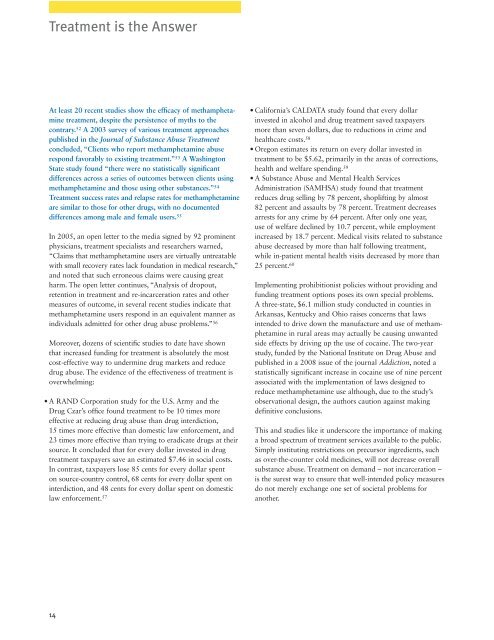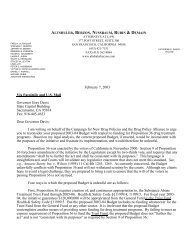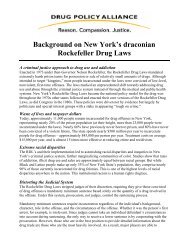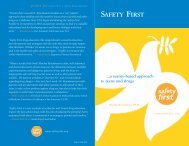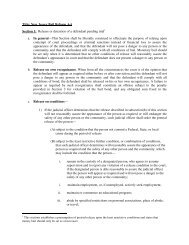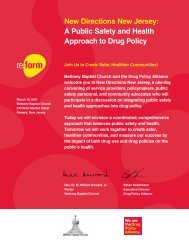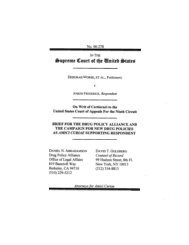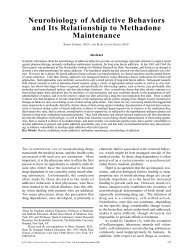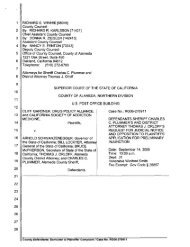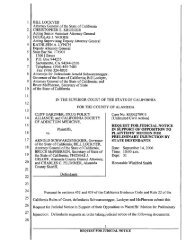A Four Pillars Approach to Methamphetamine - Drug Policy Alliance
A Four Pillars Approach to Methamphetamine - Drug Policy Alliance
A Four Pillars Approach to Methamphetamine - Drug Policy Alliance
You also want an ePaper? Increase the reach of your titles
YUMPU automatically turns print PDFs into web optimized ePapers that Google loves.
Treatment is the Answer<br />
At least 20 recent studies show the efficacy of methamphetamine<br />
treatment, despite the persistence of myths <strong>to</strong> the<br />
contrary. 52 A 2003 survey of various treatment approaches<br />
published in the Journal of Substance Abuse Treatment<br />
concluded, “Clients who report methamphetamine abuse<br />
respond favorably <strong>to</strong> existing treatment.” 53 A Washing<strong>to</strong>n<br />
State study found “there were no statistically significant<br />
differences across a series of outcomes between clients using<br />
methamphetamine and those using other substances.” 54<br />
Treatment success rates and relapse rates for methamphetamine<br />
are similar <strong>to</strong> those for other drugs, with no documented<br />
differences among male and female users. 55<br />
In 2005, an open letter <strong>to</strong> the media signed by 92 prominent<br />
physicians, treatment specialists and researchers warned,<br />
“Claims that methamphetamine users are virtually untreatable<br />
with small recovery rates lack foundation in medical research,”<br />
and noted that such erroneous claims were causing great<br />
harm. The open letter continues, “Analysis of dropout,<br />
retention in treatment and re-incarceration rates and other<br />
measures of outcome, in several recent studies indicate that<br />
methamphetamine users respond in an equivalent manner as<br />
individuals admitted for other drug abuse problems.” 56<br />
Moreover, dozens of scientific studies <strong>to</strong> date have shown<br />
that increased funding for treatment is absolutely the most<br />
cost-effective way <strong>to</strong> undermine drug markets and reduce<br />
drug abuse. The evidence of the effectiveness of treatment is<br />
overwhelming:<br />
• A RAND Corporation study for the U.S. Army and the<br />
<strong>Drug</strong> Czar’s office found treatment <strong>to</strong> be 10 times more<br />
effective at reducing drug abuse than drug interdiction,<br />
15 times more effective than domestic law enforcement, and<br />
23 times more effective than trying <strong>to</strong> eradicate drugs at their<br />
source. It concluded that for every dollar invested in drug<br />
treatment taxpayers save an estimated $7.46 in social costs.<br />
In contrast, taxpayers lose 85 cents for every dollar spent<br />
on source-country control, 68 cents for every dollar spent on<br />
interdiction, and 48 cents for every dollar spent on domestic<br />
law enforcement. 57<br />
• California’s CALDATA study found that every dollar<br />
invested in alcohol and drug treatment saved taxpayers<br />
more than seven dollars, due <strong>to</strong> reductions in crime and<br />
healthcare costs. 58<br />
• Oregon estimates its return on every dollar invested in<br />
treatment <strong>to</strong> be $5.62, primarily in the areas of corrections,<br />
health and welfare spending. 59<br />
• A Substance Abuse and Mental Health Services<br />
Administration (SAMHSA) study found that treatment<br />
reduces drug selling by 78 percent, shoplifting by almost<br />
82 percent and assaults by 78 percent. Treatment decreases<br />
arrests for any crime by 64 percent. After only one year,<br />
use of welfare declined by 10.7 percent, while employment<br />
increased by 18.7 percent. Medical visits related <strong>to</strong> substance<br />
abuse decreased by more than half following treatment,<br />
while in-patient mental health visits decreased by more than<br />
25 percent. 60<br />
Implementing prohibitionist policies without providing and<br />
funding treatment options poses its own special problems.<br />
A three-state, $6.1 million study conducted in counties in<br />
Arkansas, Kentucky and Ohio raises concerns that laws<br />
intended <strong>to</strong> drive down the manufacture and use of methamphetamine<br />
in rural areas may actually be causing unwanted<br />
side effects by driving up the use of cocaine. The two-year<br />
study, funded by the National Institute on <strong>Drug</strong> Abuse and<br />
published in a 2008 issue of the journal Addiction, noted a<br />
statistically significant increase in cocaine use of nine percent<br />
associated with the implementation of laws designed <strong>to</strong><br />
reduce methamphetamine use although, due <strong>to</strong> the study’s<br />
observational design, the authors caution against making<br />
definitive conclusions.<br />
This and studies like it underscore the importance of making<br />
a broad spectrum of treatment services available <strong>to</strong> the public.<br />
Simply instituting restrictions on precursor ingredients, such<br />
as over-the-counter cold medicines, will not decrease overall<br />
substance abuse. Treatment on demand – not incarceration –<br />
is the surest way <strong>to</strong> ensure that well-intended policy measures<br />
do not merely exchange one set of societal problems for<br />
another.<br />
14


